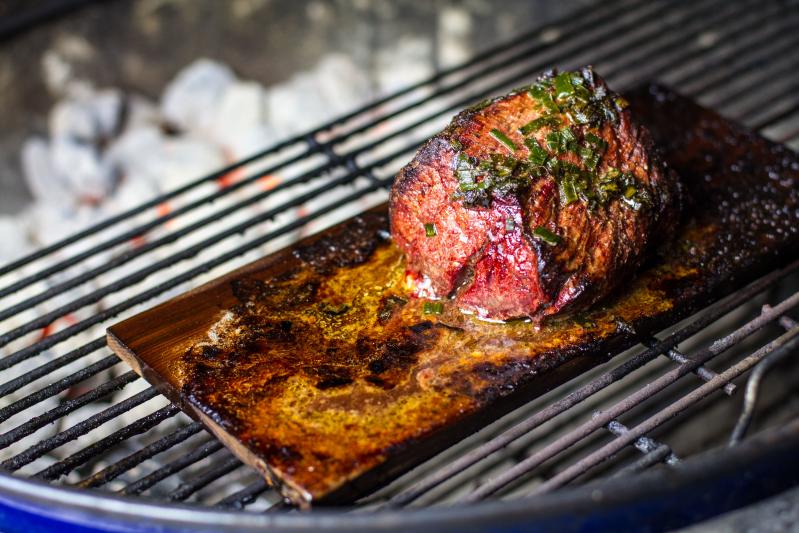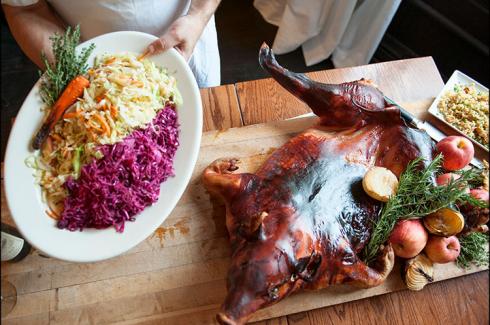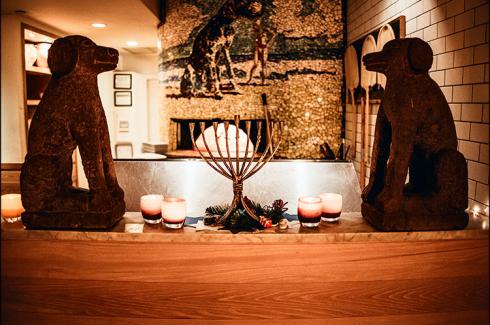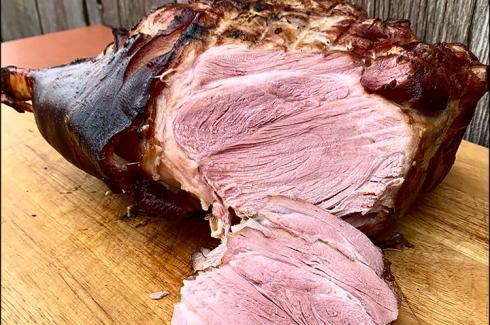When the first gas ranges were introduced in France about the middle of the 19th century, they were greatly distrusted. Meat baked in an oven was despised by Alexandre Dumas, who decreed that all food in his household be prepared on wood or charcoal fires. Grill cooks (rotisseurs) feared to lose their livelihood.
Their anxieties were fairly well founded: Almost anyone can put a roast into an oven at the temperature directed, leave it there the prescribed time, then hustle it onto the table before the carver. (This is the hardest part: finding someone who knows the manly art of carving, almost as extinct as the mustache cup.)
Outdoor grilling, not too long ago sneered at as the hallmark of suburban entertaining, has gone high-hat. Ever since the much celebrated Alice Waters came east a few years ago dragging half a boxcar of mesquite charcoal from her Chez Panisse restaurant in Berkeley, New York restaurateurs have been in a frenzy of charcoal-grillery. About the only thing I haven’t been offered grilled over mesquite are hard-boiled eggs.
We Have A Choice
But Ms. Waters has had a salutary influence. People are beginning to build their fires with greater care — without firelighter fluid — and choosing various woods to impart the smoky flavor appropriate to the particular food on the grill. Mesquite, intriguing though it may be, is not complimentary to every fish, fowl, or beast that winds up on the barbecue grill. (After pesto and goat cheese last year, this season we’re awash in mesquite and fiddlehead ferns.)
The Mexicans use mesquite because it’s what they’ve GOT. The Chinese use tea leaves because that’s what THEY’VE got. But we, my fellow Americans, have hickory, oak, cherry, apple, grapevine cuttings, and even plain saw dust from hardwood trees, which is used to smoke some of the superb hams of Vermont. Hickory is the choice for the fabled North Carolina pork barbecue, and elder is favored by many northwesterners for their wonderful fish grilled in the open.
Smoke-COOKING is another story entirely from simple outdoor grilling with maybe a handful of soaked wood chips to impart the proper smoky flavor. Hot-smoke cooking is great fun, but a fairly lengthy, if easy, process that involves some dry-curing or brining as a preliminary step. (Cold-smoking is a truly intricate lengthy process best left to professionals or the dedicated hobbyist.) Hot-smoked foods have no more keeping properties than plain charcoaled-grilled meats or fish.
Must Be There
During the recent inferno when summer sprang upon us like a maddened dragon, I tried to keep indoor cooking to a minimum. There is one paramount consideration if you are going to commit yourself to outdoor grilling: You have to be there. Constantly. Someone else must be inside washing lettuce, shucking corn, or making whatever other dishes are to be served. Get a willing helper.
An inexperienced cook may be taught, but grill cooks go berserk if they have to do inside and outside simultaneously. Brillat-Savarin’s little mot aside, grill cooks DO learn — through trial and error, tears and self-recrimination, and the decision to buy an instant-read meat thermometer. A good covered grid, a charcoal-starter can so that you don’t need to use chemical lighters, and you’re in business.
Charcoal-Grilled Beef Tenderloin
The tenderloin is, of course, the long interior muscle which is the tenderest part of a steer. The largest part is served as Chateaubriand and the narrower end cut into tournedos or filet mignon. A whole charcoal-grilled tenderloin is one of the easiest and most elegant dishes one can serve on a summer evening.
Whole tenderloins in a Cryopak seal are often on sale in supermarkets. The Cryopak greatly extends the keeping time of the meat and the last one I bought was stored, unfrozen, in my refrigerator for ten days before it was cooked.
Serves eight or ten.
1 whole beef tenderloin, "choice" grade
1/4 cup Cognac
2 Tbsp. coarsely ground black pepper
1/4 cup melted butter
Salt to taste
Grapesmoke vine cuttings* (optional)
Have the butcher remove all the fat and membrane from the beef if you are going to use it within the next couple of days. If not, you’ll have to leave it in the Cryopak and do the job yourself. There is a lot of waste fat, and I usually chop up the hard parts and render it down as it makes a delicious frying medium. Hive the tenderloin tied every couple of inches.
Dry the meat well, then lay it on a large sheet of foil and rub it well with the Cognac and pepper. Wrap it closely and refrigerate it for 24 hours.
Remove the meat from the fridge and let stand while preparing your charcoal fire. Use untreated hardwood charcoal and soak two fistfuls of vine cutting (or wood chips) in water for at least 30 minutes. Be sure to make a large enough fire so that, when the coals are white hot, you can arrange them in a long oblong platter to match the shape of the meat. The grill itself should be scrubbed perfectly clean with a wire brush and well oiled.
Rub the meat with the melted butter and salt it lightly. Scatter the soaked vinecuttings (or whatever wood chips you have chosen) on the coals quickly, put the grill in place, and lay the meat on top of it. The bottom drafts should be open but the top ones entirely closed.
Leave the meat undisturbed for about 20 minutes, then (again quickly) turn it over with tongs — don’t pierce the meat — and replace the cover. After 15 minutes check the interior reading with a meat thermometer. Remove the meat when it reaches 120 degrees F. Put it on a board and let it rest 15 minutes before slicing it into thinnish rounds. The meat will be evenly rare but not “blue” — nor will the outside be charred, only nicely browned.
This tender cut is wonderful and succulent if refrigerated for several hours before slicing. It should be served cool with a spicy homemade mustard-watercress mayonnaise.
*Grapesmoke vine cuttings: These cuttings are from cabernet, merlot, and zinfandel vines. The subtle flavor of Grapesmoke doesn’t overwhelm the intrinsic flavor of whatever you are grilling. However, experiment with different woods: The Emporium Hardware Store in Sag Harbor sells mesquite and oak chunks, cherry and hickory chips, and the aforementioned metal charcoal starter, which enables you to get a good hot bed of coals quickly without the use of chemical firelighter.





